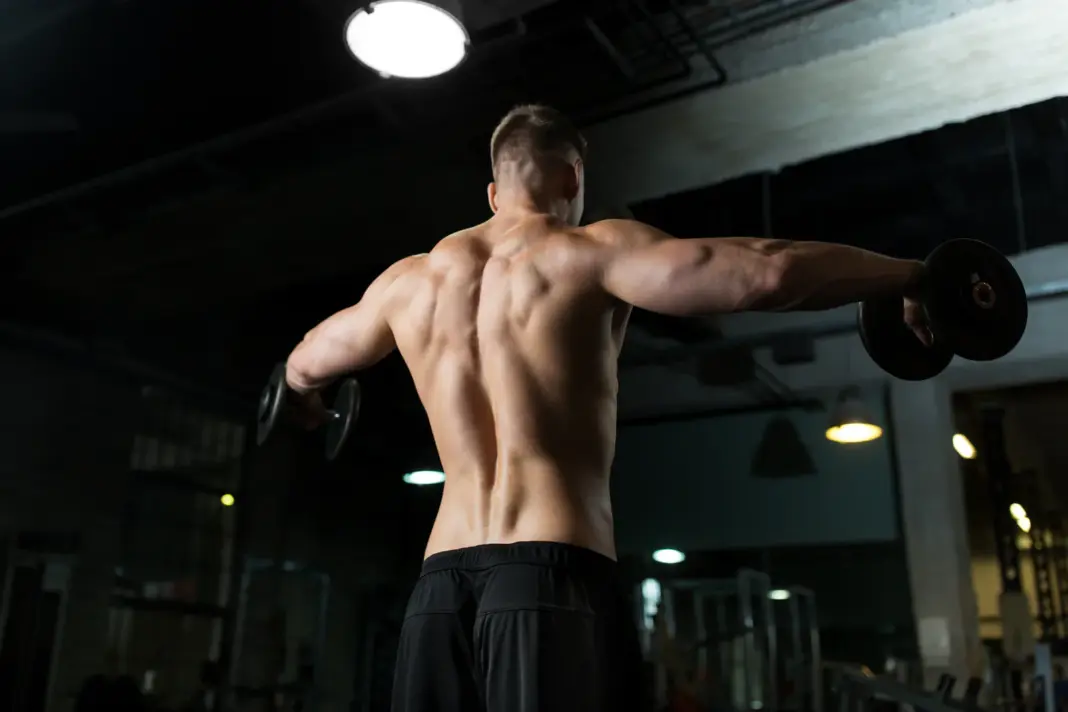High-Volume Side Delt Training for Capped Shoulders
If you want shoulders that stand out on stage or in the gym, your side delts need to grow — and grow big.
The problem? Most lifters under-train them, thinking a couple of half-hearted lateral raises after pressing is enough.
It’s not.
To build truly capped shoulders, you need a high-volume approach tailored to the side delts’ anatomy and recovery abilities.
This article breaks down why high-volume training works for the side delts, how to structure it, and exactly what workouts to run for maximum width and roundness.
Why Side Delts Respond to High Volume
The side deltoids are a small muscle group, but they’re heavily slow-twitch dominant. That means they’re built to handle more work and recover quickly compared to, say, your chest or quads.
For bodybuilders, that’s a blessing. It means:
- You can train them multiple times per week.
- They respond better to higher reps (10–20+) and longer time under tension.
- Volume is a primary growth driver for them — not max weight.
Simply put: if you want wide, capped shoulders, frequency and volume matter more than chasing PRs on presses.
The Problem With Pressing for Delts
A lot of lifters rely on pressing movements (overhead press, Arnold press, machine press) thinking that will blow up their side delts. The reality?
- Pressing heavily targets the front delts.
- The side delts only get partial stimulation as secondary movers.
- Over-relying on presses creates imbalances (big front delts, weak side delts).
To fix this, you need dedicated high-volume lateral work.
High-Volume Side Delt Training Principles
- Hit them 2–3x per week
- Add a side delt focus day OR sprinkle them into push/upper sessions.
- Prioritize isolation
- Dumbbell, cable, and machine lateral raises are non-negotiable.
- Mix rep ranges
- 8–12 reps: mechanical tension
- 12–20 reps: hypertrophy & metabolic stress
- 20+ reps: burnouts/finishers
- Control tempo
- 2–3 seconds up, slow controlled lowering.
- No bouncing, no swinging.
- Pre-exhaust or finish with them
- Start with laterals to fully engage the side delts.
- Or finish your session with high-rep burnouts.
Sample High-Volume Side Delt Workout
Here’s a dedicated shoulder session focused on side delt growth:
Warm-Up (5–10 minutes)
- Band pull-aparts, external rotations, light dumbbell raises.
Main Session
- Seated Dumbbell Lateral Raises – 4×12–15
- Sit upright, keep elbows soft, lift to shoulder height.
- Lean-Away Cable Lateral Raises – 4×12–15 each arm
- Constant tension from start to finish.
- Machine Lateral Raises – 4×15–20
- Focus on full contraction, slow negative.
- Dumbbell “Y” Raises – 3×15
- Slightly forward raise, hits side + front delts.
- Lateral Raise Drop Set (Burnout) – 3 sets to failure
- Example: 12 reps heavy → drop 20% → 12 more reps → drop 20% → to failure.
Push/Upper Day Integration
If you don’t want a full delt day, here’s how to plug them into your push session:
- Bench press or overhead press (compound lift)
- Incline dumbbell press (secondary compound)
- Dumbbell lateral raises: 4×12–15
- Cable lateral raises: 3×15–20
- Rear delt fly (for balance): 3×15–20
This ensures your side delts don’t get skipped while still supporting pressing strength.
Advanced Side Delt Specialization
If your shoulders are a weak point, here’s a side delt specialization routine (run for 8–12 weeks):
- Train side delts 3x per week.
- Use different modalities each session:
- Day 1: Dumbbell laterals (free weights)
- Day 2: Cable laterals (constant tension)
- Day 3: Machine laterals (safe failure sets)
- Finish one session with a 100-rep lateral raise challenge.
This approach builds volume while keeping fatigue manageable.
Recovery & Progression
With high-volume delt work, recovery becomes crucial:
- Rest days: Space side delt sessions by 48 hours.
- Sleep & nutrition: Adequate protein and carbs = growth fuel.
- Progression: Add weight only if form is flawless. More often, add sets or reps instead of piling on load.
Common Mistakes With High-Volume Delt Training
❌ Training too heavy – turns laterals into shrugs.
❌ Neglecting rear delts – creates imbalances and rounded shoulders.
❌ Low frequency – once a week won’t cut it.
❌ Poor technique – swinging weights instead of strict control.
✅ The Fix: Train side delts often, with strict form, varied angles, and high volume.
Final Takeaways
- Side delts are the key to capped shoulders.
- They respond best to isolation, high volume, and frequency.
- Pressing movements aren’t enough — lateral raises in multiple variations are essential.
- For best results, aim to hit side delts 2–3 times per week with 12–20+ reps per set and strict control.
High-volume side delt training isn’t flashy, but if you want shoulders that make your physique stand out, this is the way to do it.





